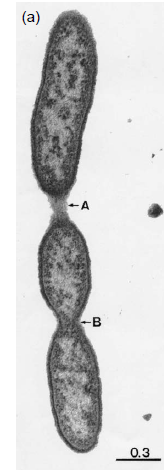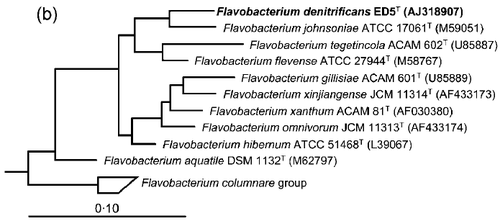Flavobacterium denitrificans: Difference between revisions
| Line 17: | Line 17: | ||
==Genome Structure== | ==Genome Structure== | ||
[[File:Flavobacteriumtree.png|500px|thumb|left| | [[File:Flavobacteriumtree.png|500px|thumb|left|Figure 2. Phylogenetic positions of “flavobacterium dentitrificans” is indicated here. ]] | ||
The G+C content of ''Flavobacterium denitrificans '' 42.6 mol%. The 1Ss rRNA gene sequence was phylogenetically most closely related to the 16S rRNA gene sequences of “Flavobacterium flevense” and “Flavobacterium johnsoniae” (95% sequence similarities). It also clustered the 16S rRNA gene sequences of other type strains of the “Cytophaga-Flavobacteia” group. This shows the phylogeny of the genus “Flavobacterium” Is uncertain. | The G+C content of ''Flavobacterium denitrificans '' 42.6 mol%. The 1Ss rRNA gene sequence was phylogenetically most closely related to the 16S rRNA gene sequences of “Flavobacterium flevense” and “Flavobacterium johnsoniae” (95% sequence similarities). It also clustered the 16S rRNA gene sequences of other type strains of the “Cytophaga-Flavobacteia” group. This shows the phylogeny of the genus “Flavobacterium” Is uncertain. | ||
Revision as of 12:27, 24 April 2013
Classification
Bacteria; Bacteroidetes/Chlorobi group; Bacteroidetes; Flavobacteriia; Flavobacteriales; Flavobacteriaceae; Flavobacterium
Species
Flavobacterium denitrificans
Description and Significance
Flavobacterium denitrificans” has flat, circular and yellow colonies. It is a facultative aerobe and an active member of the soil microbial community. It is activated in the earthworm (“Aporrectodea caliginosa”) gut, an anoxic and substrate rich habitat. Flavobacterium denitrificans” carries out denitrificaiton, whish is the dissimilative reduction of nitrate and nitrite to atmospheric nitrogen. This process can also result in a significant production of nitrous oxide, a powerful greenhouse gas. Earthworms may account for more than 50% of the total nitrous oxide emitted form a soil they inhabit.
Genome Structure
The G+C content of Flavobacterium denitrificans 42.6 mol%. The 1Ss rRNA gene sequence was phylogenetically most closely related to the 16S rRNA gene sequences of “Flavobacterium flevense” and “Flavobacterium johnsoniae” (95% sequence similarities). It also clustered the 16S rRNA gene sequences of other type strains of the “Cytophaga-Flavobacteia” group. This shows the phylogeny of the genus “Flavobacterium” Is uncertain.
Cell Structure, Metabolism and Life Cycle
Flavobacterium denitrificans cells (0.8-3.0x0.3-0.9) are facultative, in chains from 3-14, rods, gram –negative, motile and sometimes contain connecting filaments. They form colonies that are flat, circular and yellow. Outer and cytoplasmic membranes were observed. Membranes contain c-type cytochromes, but b-type cytochromes may also occur. It is flexirubin reaction-, arginine dihydrolase- and catalase-positive and oxidase- and lysine decarboxylase negative.
Many sugars (as well as proteins) and other compounds (including proteins) can support it as electron donors. It utilizes arabinose, cellobiose, fructose, fumarate, gelatin, glucose, glutamate, inulin, lactose, maltose, mannitol, mannose, N-acetylglucosamine, pectin, starch, succinate and xylose as electron donors. 1-Butanol, 1-propanol, acetate, butyrate, chitin, citrate, ethanol, ethanolamine, glycerol, glycolate, i-butyrate, inositol, i-valerate, lactate, oxalate, propionate, raffinose, saccharose, sorbitol and tartrate do not supportive growth.
Oxygen, nitrate and nitrite are used as electron acceptors but not iron(III) and sulphate. Ammonium is used as a nitrogen source. Nitrous oxide is produced as a transient intermediate during the dissimilatory reduction of nitrate to atmospheric nitrogen.
Ecology and Pathogenesis
References
Drake, Harold L., and Marcus A. Horn. "As the worm turns: the earthworm gut as a transient habitat for soil microbial biomes." Annu. Rev. Microbiol. 61 (2007): 169-189.
Horn, Marcus A., et al. "Dechloromonas denitrificans sp. nov., Flavobacterium denitrificans sp. nov., Paenibacillus anaericanus sp. nov. and Paenibacillus terrae strain MH72, N2O-producing bacteria isolated from the gut of the earthworm Aporrectodea caliginosa." International journal of systematic and evolutionary microbiology 55.3 (2005): 1255-1265.
Philippot, Laurent, Sara Hallin, and Michael Schloter. "Ecology of denitrifying prokaryotes in agricultural soil." Advances in Agronomy 96 (2007): 249-305.
Author
Page authored by Kate Glanville & Di Liang, students of Microbial Ecology at Michigan State University.



